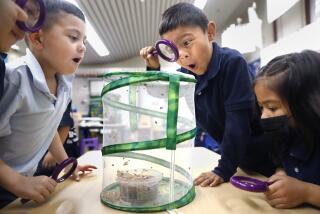One Parent’s Mission: Change the Curriculum
- Share via
The saying goes, “It takes a village to raise a child.” In California around this time of year, parents of fourth-grade students amend the aphorism to: “It takes a family to raise an Indian village as well as its accompanying mission.”
My mission odyssey began two years ago when my daughter was in private school. I helped her study for tests covering Father Junipero Serra and the California mission system. My daughter was assigned the San Fernando Mission as a research project. Students designed their own website to display their mission. After what seemed to be almost a third of the school year of social studies designed solely around missions, I was relieved when they finally moved on to the Gold Rush.
Having grown up in South Dakota, where we spent a short time on South Dakota history, including Lewis and Clark and the Missouri River and the history of westward expansion, I believe there is value in studying about the state you live in. Overall, however, it doesn’t make sense to spend months on one state. Students who moved to California in fifth grade would have missed the minutiae of the mission system. Conversely, if we moved to New Jersey tomorrow, a great deal learned in fourth-grade social studies wouldn’t help my child’s future.
When I voiced my reservations to the head of the school about the amount of time spent on missions, she pointed out that they were just following the state curriculum guidelines. I bit my tongue and didn’t say that California fourth-grade students tend to rank among the worst in the country in geography.
My son, a fourth-grader in public school, has a mission project due this month. He had three options: a video/photographic essay on the mission of his choice, a written report, or a model containing the eight features common to all missions. Oh, and by the way, this is a project the entire family can participate in; perhaps a trip to the mission might be fun.
A ski trip is fun; family game night is fun; going to the beach and helping pick up trash can be a fun project. Requiring the entire family to help build a mission is not fun. This fun and imaginative project has now cost three trips to Michael’s and more than $100. Several smart entrepreneurs have made a whole business of missions. If you choose to make a model, there are kits, complete with paper tile roofs, miniature brooms, bales of hay and bells.
Of course, teachers are not requiring students to buy anything; instead they admonish students not to use kits, but their imaginations. Children can buy a bag of clay, but then you need paint and brushes. At some point the parents are having so much fun, they simply throw the cash down and buy the items, rather than fashioning a toothpick cross (which may require a glue gun as well as patience, which wore out about two days ago when the child got tired of trying to carve a fountain out of Styrofoam and left the project to the parent).
I can afford to spend $3 on a miniature bucket, but do I want to? I’m sure not every family is as fortunate as ours with discretionary income or a parent willing to help.
One parent told me it’s important to study California history because it’s easier for children to learn about where they live. At 9 and 10, I think children are capable of learning about other places as well. Fourth-graders spend too much time on California history, especially missions. It’s time to reevaluate the curriculum.
More to Read
Sign up for Essential California
The most important California stories and recommendations in your inbox every morning.
You may occasionally receive promotional content from the Los Angeles Times.










